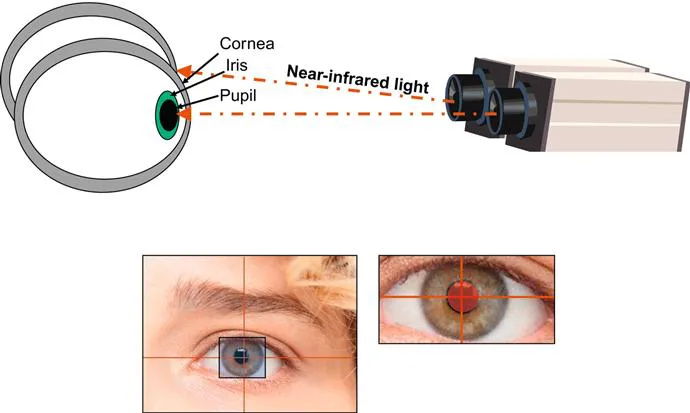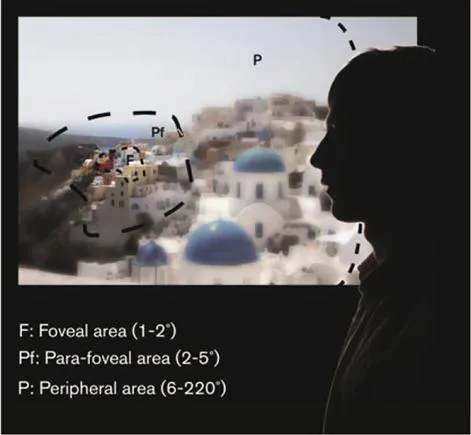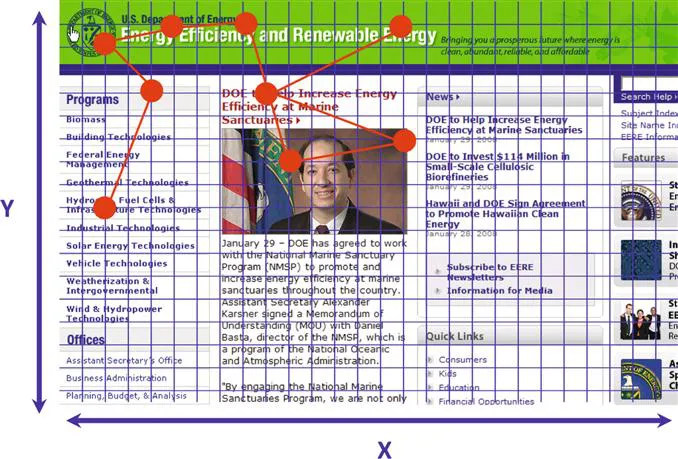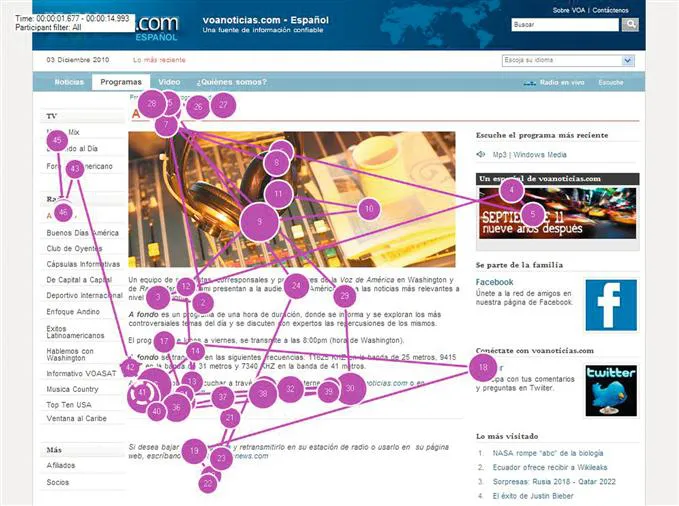
- 400 pages
- English
- ePUB (mobile friendly)
- Available on iOS & Android
eBook - ePub
Eye Tracking in User Experience Design
About this book
Eye Tracking for User Experience Design explores the many applications of eye tracking to better understand how users view and interact with technology. Ten leading experts in eye tracking discuss how they have taken advantage of this new technology to understand, design, and evaluate user experience. Real-world stories are included from these experts who have used eye tracking during the design and development of products ranging from information websites to immersive games. They also explore recent advances in the technology which tracks how users interact with mobile devices, large-screen displays and video game consoles. Methods for combining eye tracking with other research techniques for a more holistic understanding of the user experience are discussed. This is an invaluable resource to those who want to learn how eye tracking can be used to better understand and design for their users.
- Includes highly relevant examples and information for those who perform user research and design interactive experiences
- Written by numerous experts in user experience and eye tracking
- Highly relevant to anyone interested in eye tracking & UX design
- Features contemporary eye tracking research emphasizing the latest uses of eye tracking technology in the user experience industry
Frequently asked questions
Yes, you can cancel anytime from the Subscription tab in your account settings on the Perlego website. Your subscription will stay active until the end of your current billing period. Learn how to cancel your subscription.
No, books cannot be downloaded as external files, such as PDFs, for use outside of Perlego. However, you can download books within the Perlego app for offline reading on mobile or tablet. Learn more here.
Perlego offers two plans: Essential and Complete
- Essential is ideal for learners and professionals who enjoy exploring a wide range of subjects. Access the Essential Library with 800,000+ trusted titles and best-sellers across business, personal growth, and the humanities. Includes unlimited reading time and Standard Read Aloud voice.
- Complete: Perfect for advanced learners and researchers needing full, unrestricted access. Unlock 1.4M+ books across hundreds of subjects, including academic and specialized titles. The Complete Plan also includes advanced features like Premium Read Aloud and Research Assistant.
We are an online textbook subscription service, where you can get access to an entire online library for less than the price of a single book per month. With over 1 million books across 1000+ topics, we’ve got you covered! Learn more here.
Look out for the read-aloud symbol on your next book to see if you can listen to it. The read-aloud tool reads text aloud for you, highlighting the text as it is being read. You can pause it, speed it up and slow it down. Learn more here.
Yes! You can use the Perlego app on both iOS or Android devices to read anytime, anywhere — even offline. Perfect for commutes or when you’re on the go.
Please note we cannot support devices running on iOS 13 and Android 7 or earlier. Learn more about using the app.
Please note we cannot support devices running on iOS 13 and Android 7 or earlier. Learn more about using the app.
Yes, you can access Eye Tracking in User Experience Design by Jennifer Romano Bergstrom,Andrew Schall in PDF and/or ePUB format, as well as other popular books in Computer Science & Computer Graphics. We have over one million books available in our catalogue for you to explore.
Information
Section 1
Overview of Eye Tracking and Visual Search
Outline
1
Introduction to Eye Tracking
Andrew Schall1 and Jennifer Romano Bergstrom2, 1Spark Experience, Bethesda, MD, USA, 2Fors Marsh Group, Arlington, VA, USA
Abstract
This chapter contains a brief history of eye tracking and how it has become a valuable methodology for user experience researchers. Readers will gain a basic understanding of how eye trackers can track the location of a user’s eye gaze and common visualizations used to analyze the eye-tracking data output.
Keywords
eye tracker; eye tracking; history of eye tracking; user experience; user research; UX; vision science
What is eye tracking?
Eye tracking is a methodology that helps researchers understand visual attention. With eye tracking, we can detect where users look at a point in time, how long they look at something, and the path their eyes follow (Figure 1.1). Eye tracking has been applied to numerous fields including human factors, cognitive psychology, marketing, and the broad field of human–computer interaction. In user experience research, eye tracking helps researchers understand the complete user experience, even that which users cannot describe.

How eye tracking works
An eye tracker is a tool that allows user experience (UX) researchers to observe the position of the eye to understand where an individual is looking. Most modern eye trackers rely on a method called corneal reflection to detect and track the location of the eye as it moves. Corneal reflection uses a light source to illuminate the eye, which then causes a reflection that is detected by a high-resolution camera. The image captured by the camera is then used to identify the reflection of the light source on the cornea and in the pupil, as shown in Figure 1.2. Advanced image processing algorithms are then used to establish the point of gaze related to the eye and the stimuli.

The same eye-tracking methodology applies no matter what the individual is looking at. Even though our vision appears extremely stable, the eye is constantly moving around to help construct a complete picture of what we are looking at.
This process is divided into fixation and saccades. A fixation is the pause of the eye movement on a specific area of the visual field. These pauses are often extremely brief, as the eye continually performs saccades. Saccades are rapid movements of the eye from one fixation to another to help the eye piece together a complete scene of what an individual looks at. You might assume that fixations and saccades give us a clear picture of what an individual perceives, but this is not the whole story.
Fixations take place in our foveal vision, which accounts for nearly half of the visual information sent to our brain (see Figure 1.3). This part of our vision is highly detailed and provides complete clarity about what we are looking at. Our primary attention is usually focused on what we register in our foveal vision. Eye trackers only track what is registered in an individual’s foveal vision. Unfortunately, this only accounts for less than 8% of our visual field (Tobii Technology, 2010).

The rest of our vision is composed of parafoveal and peripheral vision. These regions surround our foveal vision and help us to gain a sense of what is happening around us. These types of vision are almost certainly the result of evolution where our ancestors needed to worry about potential predators out of the corner of their eye. Stimuli registered in either parafoveal or peripheral vision tend to be things that involve a lot of movement (again, think about human evolution). The stimuli detected are low resolution and only give us a sense of an object’s general color, shape, and motion (Rayner, 1998).
While we cannot detect the details of objects in these regions of our vision, our brain is pretty good about theorizing what the object could be. This is an extremely powerful capability that provides us with the ability to scan a website and get the lay of the land within a few moments without carefully reading all of the content. Our mind can compose a high-level understanding of a scene within seconds.
This makes it tricky to analyze eye-tracking data. Just because a user did not specifically fixate an image does not mean that they are not aware that it is there. They might even be able to identify page elements without fixating them for any detectable period of time.
Eye tracking’s unique ability to detect and follow the eye as it looks at stimuli has given UX researchers and designers a much better understanding of how the human visual system works.
What eye trackers can and cannot tell us
An eye tracker can be a powerful tool that gives us a highly accurate representation and understanding of an individual’s eye movement behavior. The three attributes of location, duration, and movement form the basis for this understanding.
Location
The location of a user’s eye gaze at a particular moment in time (i.e., a fixation) provides the most basic unit of analysis for understanding visual attention. Fixations are extremely short and typically only last between 100 and 600 milliseconds. Fixations can be mapped to specific x and y coordinates on a grid that help pinpoint where the user looked on a given display (Figure 1.4).

The challenges with interpreting mapped fixations lie in the fact that just because a fixation was registered does not necessarily mean that the user really saw it or that it registered cognitively in their brain. This is often the case with orphan fixations where the eye may have momentarily rested in a random area of the screen but did not intentionally look at it, such as when users complete forms that require created answers, as discussed in Chapter 5. In these cases, users look at the screen, but their attention is elsewhere, and thus the eye-tracking data are not useful.
The clustering of a number of fixations in a particular region can provide more evidence that the user deliberately looked at something, and significantly increases the likelihood that the brain processed it. However, eye trackers are not mind-reading devices, and they can only tell us what the person looked at but not why.
Duration
The length of time that a user fixates a particular area on the screen (as shown in a gaze plot diagram in Figure 1.5) helps us to understand whether he/she is paying particular attention to a specific visual element. The duration of fixations is often extremely short and is typically represented in milliseconds.

Unfortunately, duration is a particularly difficult measurement to interpret. There are many possible reasons why a user fixates for a relatively short or long period of time on a particular area. Are they confused by this element? Do they find it engaging? In order to understand these measurements we need to look at the data in context with other research methods. This will be discussed extensively in Chapter 3.
Movement
The movement of a user’s eyes is based on saccades from one fixation ...
Table of contents
- Cover image
- Title page
- Table of Contents
- Copyright
- Dedication
- Acknowledgments
- About the Editors
- List of Contributors
- Foreword
- Section 1: Overview of Eye Tracking and Visual Search
- Section 2: Evaluating the User Experience
- Section 3: Eye Tracking for Specific Applications
- Section 4: Eye Tracking with Unique Populations
- Section 5: Conclusion
- Glossary
- Index